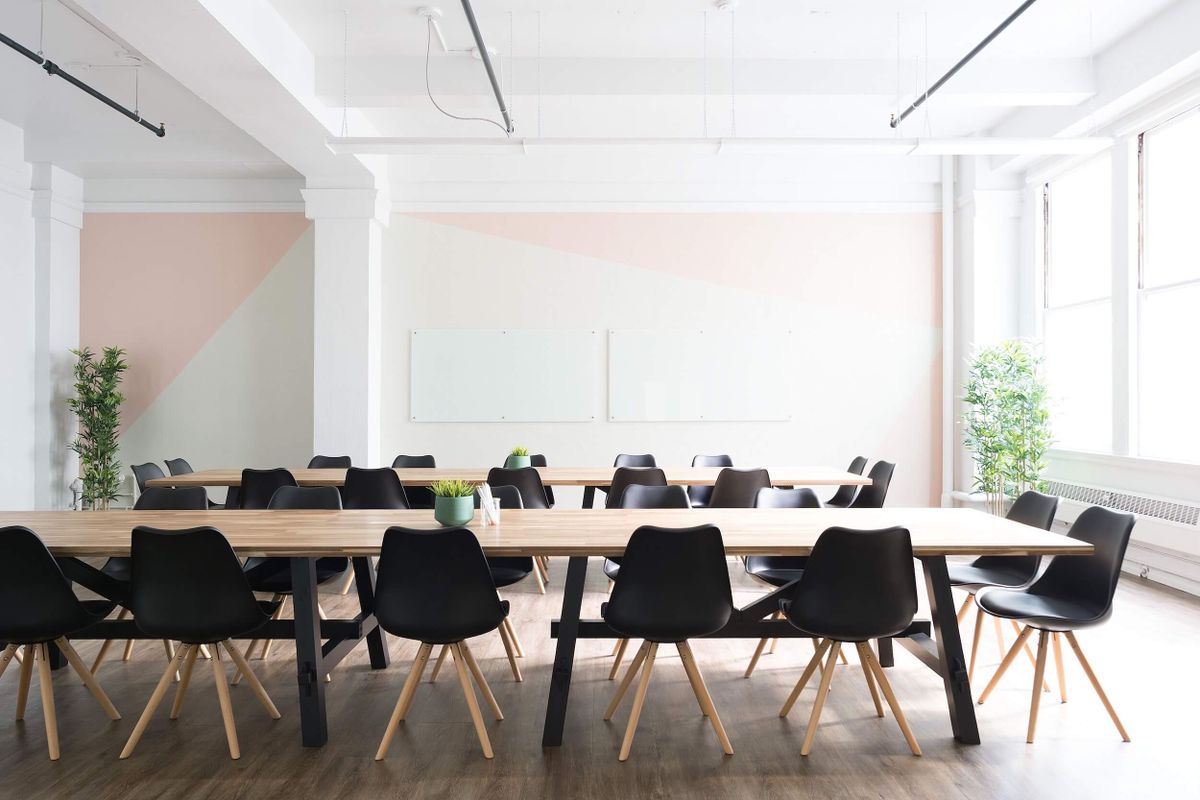Productivity, the office, and the open floor plan

UPDATE: this article was written at a time when remote work wasn't so widespread. After having worked remotely myself, I don't think that the office is so critical anymore, even though I believe it's still useful to have a nice office somewhere where you can meet people in person, every now and then. But a very nice office is even more important nowadays; if your office sucks, there're zero chance that people will want to go there!
There's one pattern that, nowadays, I find amusing; the productivity mantra is repeated everywhere. Everybody wants to get more productive, every company is trying to make their employees more productive. Robotics, AI: everything calls for it.
From Wikipedia:
Productivity describes various measures of the efficiency of production. A productivity measure is expressed as the ratio of output to inputs used in a production process, i.e. output per unit of input
So: productivity is a ratio.
That's a great idea! Let's do more work in less time, and let's use the rest of our time in other activities - be it study, research, exercise, leisure time, or whatever.
Or, let's do more work in the same time as before! That's a good idea as well; we'll achieve more, and maybe, if our company recognizes such additional value, get paid more.
But then. Open floor plans. Shared desks.

How can those things go together?
Focusing on software development/tech firms, there seem to exist a widespread discontent around open floor plans, and yet the number of companies adopting them seem to be growing - I don't have exact data, but it seems to be a new trend. Traditional corporations that want to start behaving like startups start ditching private offices. The usual reason: an open office workspace promotes collaboration. Yes, maybe it does. But do all the employees in a company just collaborate between each other all the time?
Most probably, they won't. Most probably, they'll need plenty of time to focus and do deep work. The risk is to overoptimize for a single aim, and forget the whole picture.
More often than not, an open office plan is a marketing synonym for let's cram how many people we can, quite at random, in the smallest possible space.
Incidentally, I think that open office workspaces are one of the reasons[1] that actually make 100% remote work positions effective: the productivity drop of open workspaces is larger than the drop caused by collaboration/communication difficulties in remote work situations.
Personally, I think that a good office trumps any other work environment/style in terms of productivity. Of course, life is a multi-objective optimization; can you find all the employees you need around a specific location? Are you paying high enough for those employees to live comfortably around that office? If any of those answers are not a definite yes, hybrid or full remote makes a lot of sense!
But, how should a good office be organized? I have experienced a variety of work environments and, well, in my opinion a sort-of open space rooms work fine, even great, but there're some dispositions:
- Don't make them too large. Around 100/150m2 (1000-1500 sqft) should be ok to accommodate enough people working together.
- Reserve enough space for each worker. Usually 7-10m2 (70-100 sqft) for each person is a good guidance.
- Make sure desks are personal, and they're deep and wide enough. No desk should be narrower than 150cm (60 inches), and ideally you should aim at 180/200cm (70-80 inches). It should be possible for two people to sit at the same desk at any time, without messing with table legs, other people's legs, or any other item. Pursue no friction for collaboration.
- Provide some place (lockers, cabinets, whatever) to let people put their personal and work belongings in, so the desktop area can be tidy and clear.
- Provide good tools. Large screens, powerful workstations, if needed.
- Make sure that both visual and auditory noises are minimal. While at his desk, any worker should not be able to see their peers' monitors. Phones should be silenced. People requiring to make constant noise (e.g. salesmen, tech support) should not be put in the same room as deep-working people (e.g. software developers). Carpeted floors and doors that can actually be closed can be very useful.
- Respect privacy and safety. People should not fear shoulder surfing or that anybody could approach them without being seen, because that prevents many workers from getting relaxed enough to enter a flow state of mind.
- Offices should not be hallways. There should be no need for somebody to cross a room just to reach another place.
- Enforce a behavioural code. Talking is totally permitted, albeit in a low voice and not shouting around the room. I find pair programming 100% fine in such environments.
- Provide other community space, with whiteboards, large screens, coffee, snacks, where people can meet & discuss when they need to collaborate rather than focus.
Using this kind of office space, you can accommodate 10-15 developers in a room, and change their position when they need to constantly work with somebody else. Collaboration turns out to work out properly, but distractions are limited. A decent trade-off.
What I finally argue is: if you're using an open floor plan just to cram more people in the same space, you're not improving productivity. You're (possibly) just improving total production. Because more people working in a bad environment could still produce more than fewer people in a good environment.
But, take some time to do some calculations. Your engineers are possibly the most expensive part of your budget. Are you totally sure that you'd want to spend a conspicuous amount of money for their wage, and then let them work at a fraction of their potential efficiency? This is especially relevant within the context of remote or hybrid work. Try comparing hybrid/full remote expenses to the ones of having everybody in good office, not in a terrible one.
Sure, real estate and rents are a cost. A distracting work environment won't reduce their abilities 1% or 2%. I'd speculate that the productivity drop can easily reach 20%-50%. Take note of your "developer density" and when it's approaching the limit, start looking for new office space. Don't wait to be Too Crammed To Do Anything Useful.
Sometimes I hear somebody say that "hey, that's how it works nowadays, adapt or be ejected, I can work with noise and distractions". Let's suppose that such people actually exist and do a lot of great work; how many of them can you recruit in the current state of talent crunch? And, are you really sacrificing a lot people that could do great work on the altar of smaller offices? Remember: when creating an office space for a team, you should think about the whole team, a lot of different people. Even though it works for you, it may not work for them. That's true for hybrid/remote as well; you need to select the right people to work at the office, and those may not be the best remote workers; and vice-versa.
UPDATE July, 20th 2018:
There're more and more people that agree with me about open floor plans, in that they're detrimental to productivity and conversation:
https://theconversation.com/a-new-study-should-be-the-final-nail-for-open-plan-offices-99756
https://code.likeagirl.io/a-research-roundup-to-show-that-your-office-layout-is-toxic-and-some-tips-for-making-it-better-8434864b0ab2
https://m.signalvnoise.com/the-open-plan-office-is-a-terrible-horrible-no-good-very-bad-idea-42bd9cd294e3
https://joshuatdean.com/wp-content/uploads/2020/02/NoiseCognitiveFunctionandWorkerProductivity.pdf
Photos by Breather and Annie Spratt
The other one being long commutes that waste time and destroy workers' morale. ↩︎

